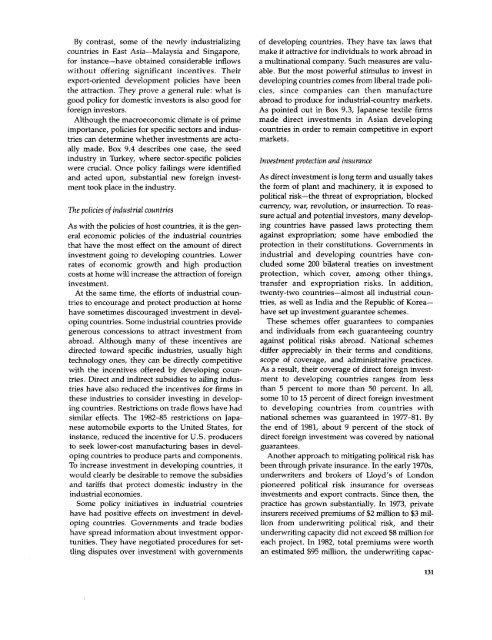World Bank Document
World Bank Document
World Bank Document
Create successful ePaper yourself
Turn your PDF publications into a flip-book with our unique Google optimized e-Paper software.
By contrast, some of the newly industrializing of developing countries. They have tax laws that<br />
countries in East Asia-Malaysia and Singapore, make it attractive for individuals to work abroad in<br />
for instance-have obtained considerable inflows a multinational company. Such measures are valuwithout<br />
offering significant incentives. Their able. But the most powerful stimulus to invest in<br />
export-oriented development policies have been developing countries comes from liberal trade polithe<br />
attraction. They prove a general rule: what is cies, since companies can then manufacture<br />
good policy for domestic investors is also good for abroad to produce for industrial-country markets.<br />
foreign investors.<br />
As pointed out in Box 9.3, Japanese textile firms<br />
Although the macroeconomic climate is of prime made direct investments in Asian developing<br />
importance, policies for specific sectors and indus- countries in order to remain competitive in export<br />
tries can determine whether investments are actu- markets.<br />
ally made. Box 9.4 describes one case, the seed<br />
industry in Turkey, where sector-specific policies Investment protection and insurance<br />
were crucial. Once policy failings were identified<br />
and acted upon, substantial new foreign invest- As direct investment is long term and usually takes<br />
ment took place in the industry.<br />
the form of plant and machinery, it is exposed to<br />
political risk-the threat of expropriation, blocked<br />
The policies of industrial countries<br />
currency, war, revolution, or insurrection. To reassure<br />
actual and potential investors, many develop-<br />
As with the policies of host countries, it is the gen- ing countries have passed laws protecting them<br />
eral economic policies of the industrial countries against expropriation; some have embodied the<br />
that have the most effect on the amount of direct protection in their constitutions. Governments in<br />
investment going to developing countries. Lower industrial and developing countries have conrates<br />
of economic growth and high production cluded some 200 bilateral treaties on investment<br />
costs at home will increase the attraction of foreign protection, which cover, among other things,<br />
investment. transfer and expropriation risks. In addition,<br />
At the same time, the efforts of industrial coun- twenty-two countries-almost all industrial countries<br />
to encourage and protect production at home tries, as well as India and the Republic of Koreahave<br />
sometimes discouraged investment in devel- have set up investment guarantee schemes.<br />
oping countries. Some industrial countries provide These schemes offer guarantees to companies<br />
generous concessions to attract investment from and individuals from each guaranteeing country<br />
abroad. Although many of these incentives are against political risks abroad. National schemes<br />
directed toward specific industries, usually high differ appreciably in their terms and conditions,<br />
technology ones, they can be directly competitive scope of coverage, and administrative practices.<br />
with the incentives offered by developing coun- As a result, their coverage of direct foreign investtries.<br />
Direct and indirect subsidies to ailing indus- ment to developing countries ranges from less<br />
tries have also reduced the incentives for firms in than 5 percent to more than 50 percent. In all,<br />
these industries to consider investing in develop- some 10 to 15 percent of direct foreign investment<br />
ing countries. Restrictions on trade flows have had to developing countries from countries with<br />
similar effects. The 1982-85 restrictions on Japa- national schemes was guaranteed in 1977-81. By<br />
nese automobile exports to the United States, for the end of 1981, about 9 percent of the stock of<br />
instance, reduced the incentive for U.S. producers direct foreign investment was covered by national<br />
to seek lower-cost manufacturing bases in devel- guarantees.<br />
oping countries to produce parts and components. Another approach to mitigating political risk has<br />
To increase investment in developing countries, it been through private insurance. In the early 1970s,<br />
would clearly be desirable to remove the subsidies underwriters and brokers of Lloyd's of London<br />
and tariffs that protect domestic industry in the pioneered political risk insurance for overseas<br />
industrial economies.<br />
investments and export contracts. Since then, the<br />
Some policy initiatives in industrial countries practice has grown substantially. In 1973, private<br />
have had positive effects on investment in devel- insurers received premiums of $2 million to $3 miloping<br />
countries. Governments and trade bodies lion from underwriting political risk, and their<br />
have spread information about investment oppor- underwriting capacity did not exceed $8 million for<br />
tunities. They have negotiated procedures for set- each project. In 1982, total premiums were worth<br />
tling disputes over investment with governments an estimated $95 million, the underwriting capac-<br />
131

















